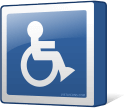Accessibility Bookmarklets and Tools
 Testing accessibility on your web projects can be a tricky task if you have no firsthand experience with visual, audible, physical or even cognitive impairment. Having resources in the community is important as is tracking down the same tools in use in that community.
Testing accessibility on your web projects can be a tricky task if you have no firsthand experience with visual, audible, physical or even cognitive impairment. Having resources in the community is important as is tracking down the same tools in use in that community.
Despite all this it’s nice to have some quick techniques for testing your sites without the need to break from your regular workflow. Conveniently, there are a number of tools already out there. Here is a quick rundown…
WCAG 2.0 parsing error bookmarklet
From Steve Faulkner, this experimental bookmarklet uses string matching to evaluate a page against the WCAG 2.0 success criterion for section 4.1.1 Parsing. It leans on the W3C Nu Markup Validator to do its job.
Get the WCAG 2.0 parsing error bookmarklet from The Paciello Group for yourself and while there, read up on how to use it.
Nu Markup Validation Service Bookmarklets
Excuses for failing to use the W3C Nu Markup Validator fall away when all you have to do to validate a page is click on a bookmarklet. Also from Steve Faulkner, this collection of four bookmarklets allows you to validate the current page (in the current window or a new one) or provide the URL of a page to validate (in a new window or not).
Get the four Nu Markup Validation Service bookmarklets (also from The Paciello Group).
Favelets for Checking Web Accessibility
Jim Thatcher has come up with a series of bookmarklets (or as he calls them, favelets) that allow him to make the human review process easier by highlighting details he might otherwise have to wade through code to see. Bookmarklets include image checkers, heading counters, data table notes, ARIA details, and form features.
Get the full collection of “favelets” for checking web accessibility and be sure to read the detailed instructions on how to use these in conjunction with a manual testing process.
Web Accessibility Toolbar
This particular tool is not a collection of bookmarklets. It is also not built to work for any browser other than Internet Explorer. It does, however, provide far more features than bookmarklets can do on their own. Used in conjunction with a manual test and the bookmarklets listed above it can help our overall accessibility testing process far more than just the bookmarklets alone.
Download the Web Accessibility Toolbar For IE and give it a test run on your sites.
If for some reason you are running Opera 8 or Opera 9, there is a version of the Web Accessibility Toolbar for Opera (but again, only 8 or 9).
Juicy Studio Accessibility Toolbar
This toolbar is a Firefox add-on from Gez Lemon. Like the toolbar above, it provides a bit more control than a bookmarklet will afford. This will show you ARIA live regions, show you ARIA landmarks and roles, provides a table inspector and a color contrast analyzer.
You can get the Juicy Studio Accessibility Toolbar from the Mozilla add-on site.
No longer available (was at https://addons.mozilla.org/en-US/firefox/addon/juicy-studio-accessibility-too/).
NonVisual Desktop Access (NVDA)
Since I’ve strayed far afield of bookmarklets I thought I would toss this last one into the mix. NonVisual Desktop Access (NVDA) is a free, open-source screen reader for Windows. While it’s intended for the entire OS, it’s also great for testing web pages. Its support of different accents makes for much fun when it speaks to me as a Scotsman.
Download a copy of NVDA for yourself and make sure to donate when you do — this is how projects like this are able to continue and how you can support the disabled community.
Somewhat Related on This Blog
- Copying Content Styled with Text-Transform, June 6, 2012
- Image alt Exception Change Re-Re-Requested, June 11, 2012
- Dining in the Dark, April 25, 2012
- Web Accessibility Sorta-Infographic, September 5, 2011
- W3C Browser and Accessibility News Bits, June 18, 2010
- Blind Students Sue Over Online Law School Applications, June 11, 2010
- Define “Cognitive Disability,” January 26, 2010
- Accessible Video and Transcripts, January 20, 2010
- W3C: Contacting Organizations about Inaccessible Websites, January 6, 2010
- How Many Disabled Users? December 13, 2009
- Tables as Consumed by JAWS, December 11, 2009
- Screen Reader User Survey Results, November 9, 2009
- Developer Discusses Dyslexia and Dyscalculia, October 15, 2009
Updated
Added Juicy Studio Accessibility Toolbar on June 25, 2012.
Updated
Removed Juicy Studio Accessibility Toolbar on December 16, 2018.
Leave a Comment or Response